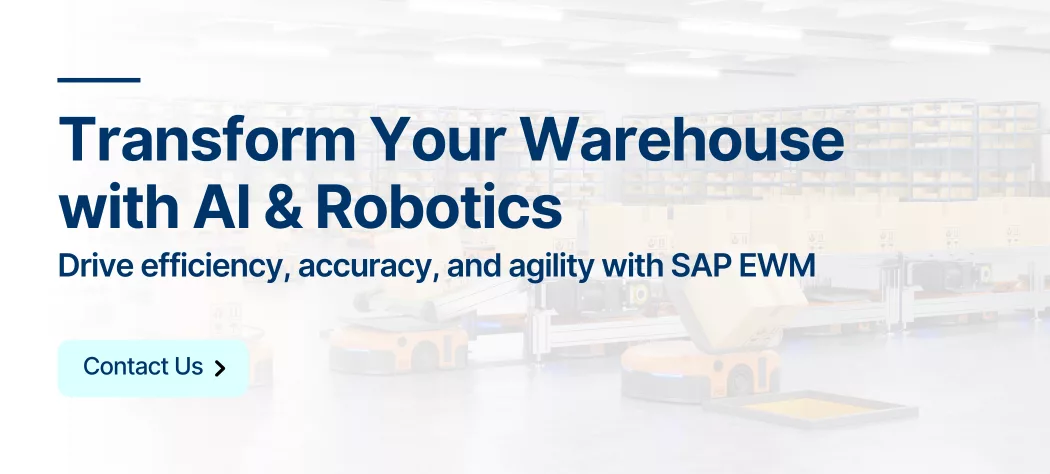

As businesses strive to enhance operational efficiency and responsiveness to customer demands, the integration of robotics and artificial intelligence (AI) into warehouse management systems has emerged as a game-changer. Leaders looking to optimize their supply chain operations are turning to solutions like SAP Extended Warehouse Management (EWM) to address critical challenges and drive innovation. This article explores how the incorporation of robotics and AI within SAP EWM can solve key organizational problems and position businesses for success in a competitive landscape.
1. Enhancing Operational Efficiency
Challenge: Warehouse operations can often be slow and labor-intensive, leading to inefficiencies that affect order fulfillment times and overall productivity.
Solution with Robotics and AI: Robotics within SAP EWM automates repetitive tasks such as picking, packing, and sorting. Autonomous Mobile Robots (AMRs) can navigate warehouse floors, transporting goods without human intervention. When combined with AI-driven decision-making capabilities, these robots can optimize their routes and workflows in real-time, significantly reducing the time it takes to fulfill orders. This results in faster turnaround times and improved operational efficiency.
2. Improving Accuracy and Reducing Errors
Challenge: Manual processes in warehouses are prone to human error, which can lead to inventory discrepancies, incorrect shipments, and customer dissatisfaction.
Solution with Robotics and AI: AI technologies integrated within SAP EWM enhance data accuracy through advanced algorithms that analyze historical data and predict inventory needs. Robotics equipped with smart sensors and machine learning capabilities can identify items accurately and confirm picks, reducing the likelihood of errors. This increased accuracy not only boosts customer satisfaction but also minimizes costs associated with returns and re-shipments.
3. Maximizing Warehouse Space Utilization
Challenge: Inefficient use of warehouse space can lead to costly overheads and limit an organization’s ability to scale operations effectively.
Solution with Robotics and AI: Robotics and AI empower organizations to optimize warehouse layouts dynamically. AI algorithms analyze inventory turnover rates and product demand to recommend optimal storage locations. Robotics can navigate more effectively in tight spaces and use vertical storage solutions, enhancing overall space utilization. By maximizing available space, organizations can accommodate a larger inventory without the need for costly expansions.
4. Enhancing Labor Management
Challenge: Workforce management can be challenging, especially when demand fluctuations require agile workforce adjustments.
Solution with Robotics and AI: AI-driven analytics within SAP EWM can forecast workforce needs based on historical data, seasonal trends, and real-time inventory fluctuations. This enables leadership to make proactive decisions about staffing levels, minimizing labor costs while ensuring adequate coverage during peak times. Furthermore, the implementation of robotics allows for reallocating human labor to more value-added tasks, increasing overall employee productivity and job satisfaction.
5. Facilitating Real-Time Decision Making
Challenge: In a rapidly changing market, leaders require access to real-time data to make informed decisions on inventory management and operational strategies.
Solution with Robotics and AI: Robotics integrated with SAP EWM continuously gather data on inventory movement, equipment performance, and operational KPIs. AI algorithms process this data, providing insights and predictive analytics that help leaders anticipate issues before they arise. The ability to make data-driven decisions in real time empowers organizations to enhance responsiveness and agility in their operations.
6. Strengthening Supply Chain Resilience
Challenge: Disruptions in the supply chain can severely impact business continuity and customer trust.
Solution with Robotics and AI: The intelligent automation afforded by robotics and AI enhances supply chain resilience by enabling organizations to adapt quickly to changes and challenges. With real-time visibility into inventory and logistics, leaders can respond proactively to supply chain disruptions—whether from supplier issues, demand spikes, or unforeseen events—ensuring continuity and reliability.
As organizations seek to navigate the complexities of modern supply chains, integrating robotics and AI into SAP EWM presents a significant opportunity to solve organizational challenges. From improving operational efficiency and accuracy to maximizing space utilization and enhancing decision-making, these technologies empower leadership to drive innovation and growth. By embracing automation and intelligence, businesses not only position themselves for success today but also lay the groundwork for a more resilient and agile future in warehouse management.
With robotics and AI at the forefront of transformation, leadership can confidently steer their organizations toward a new era of operational excellence. Contact us today.
